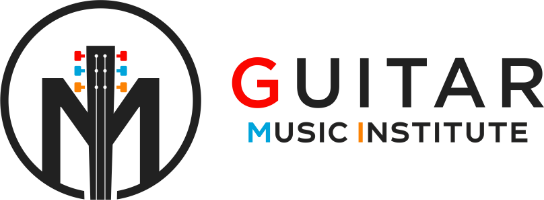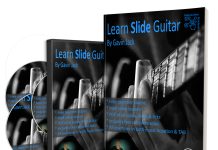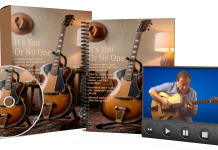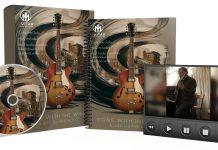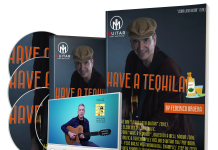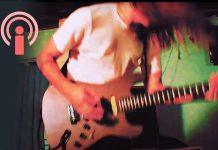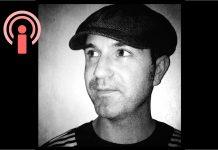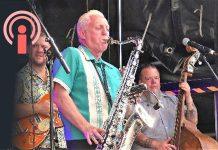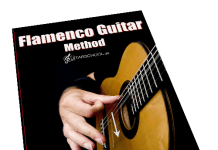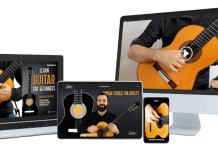This post may contain affiliate links. As an Amazon associate, Google associate as well as associate for other programs, Guitar & Music Institute may earn commissions from qualifying purchases.
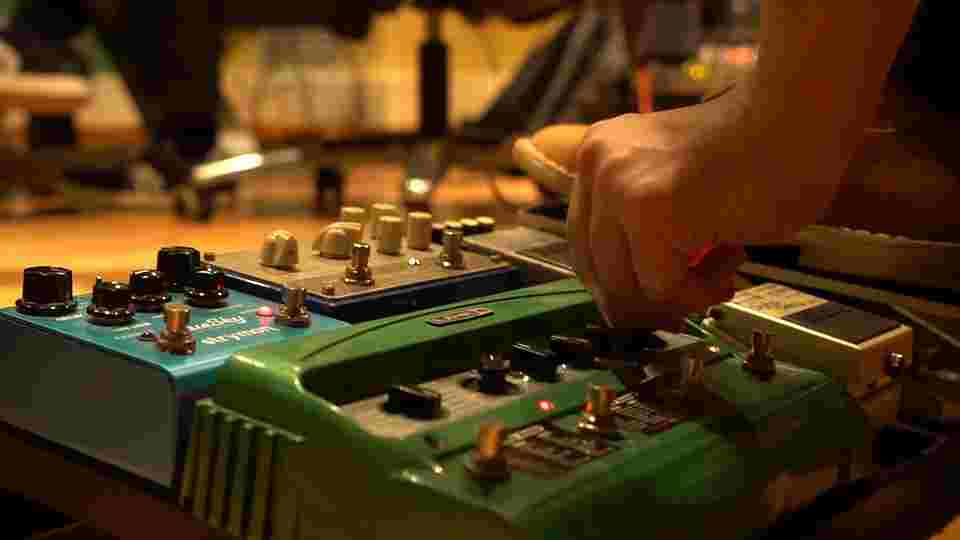 Choosing the right guitar effects pedal for your music can be a thrilling endeavor. Whether you’re a seasoned guitarist or just starting out, the world of stomp boxes and footpedals offers a plethora of possibilities to enhance your sound. From adding crunchy distortion to creating lush modulation effects, the right pedal can take your tone to new heights.
Choosing the right guitar effects pedal for your music can be a thrilling endeavor. Whether you’re a seasoned guitarist or just starting out, the world of stomp boxes and footpedals offers a plethora of possibilities to enhance your sound. From adding crunchy distortion to creating lush modulation effects, the right pedal can take your tone to new heights.
Understanding the basics of guitar effects pedals is crucial when venturing into this exciting world. The signal flow from your guitar to your amplifier is the foundation on which your sound is built. The order in which you place your effects on your pedalboard can greatly influence the final result.
When it comes to the different types of guitar effects pedals, they can be categorized into different groups based on their function. Gain-staging effects shape the foundation of your tone, while frequency effects manipulate the frequency range of your sound. Modulation effects add movement and depth, and dynamic effects control the volume and dynamics. There are also other miscellaneous effects that offer unique functionalities.
Exploring the world of guitar effects pedals can be overwhelming, but fear not! In this comprehensive guide, we will delve into each category of effects, explain their functions, and recommend some popular options for beginners. Whether you’re looking for a distortion pedal to add some grit to your riffs or a delay pedal to create lush ambient textures, we’ve got you covered.
So, grab your guitar, buckle up, and let’s embark on a sonic journey together. By the end of this guide, you’ll have a solid understanding of guitar effects pedals and be well-equipped to make your first purchase.
Key Takeaways:
- Choosing the right guitar effects pedal can greatly enhance your sound and take your playing to new heights.
- The signal flow and order of effects on your pedalboard play a significant role in shaping your tone.
- Guitar effects pedals can be categorized into gain-staging effects, frequency effects, modulation effects, dynamics effects, and other miscellaneous effects.
- Experimentation is key when finding your unique sound.
- Have fun exploring the world of guitar effects pedals and enjoy the process of discovering your sonic palette.
Understanding Gain-Staging Effects
Gain-staging effects are an essential part of shaping your guitar tone. By manipulating the gain, these effects pedals allow you to achieve various levels of distortion, compression, and volume control. In this section, we’ll delve into the different gain-staging effects and how they impact your sound.
Let’s start with gain boost pedals, also known as clean boosts. These pedals provide a powerful signal boost to hit your amplifiers and overdrive effects with an extra-hot signal. They are perfect for adding sustain, increasing headroom, and driving your tone to new heights.
Next, we have overdrive pedals, which simulate the natural breakup and saturation of an amplifier. These pedals add warmth, grit, and a touch of natural compression to your sound. Whether you’re aiming for bluesy smoothness or classic rock crunch, overdrive pedals have got you covered.
If you’re looking for a heavier and more aggressive sound, distortion pedals are the way to go. These pedals introduce intense clipping and saturation to your signal, resulting in a distinctively distorted and harmonically rich tone. From classic metal riffs to modern high-gain mayhem, distortion pedals deliver the goods.
Compression pedals play a crucial role in controlling the dynamic range of your guitar signal. By reducing the difference between the softest and loudest notes, compression evens out your tone and increases sustain. It’s a useful tool for adding consistency and enhancing the overall balance of your playing.
Volume control pedals, on the other hand, offer a practical utility for adjusting the overall volume levels during performances. They allow you to achieve smooth and precise volume swells, or quickly cut through the mix for solos and lead parts.
To summarize:
| Type of Gain-Staging Effect | Description |
|---|---|
| Gain Boost | Provides a signal boost for hitting amplifiers and overdrive effects with an extra-hot signal. |
| Overdrive | Simulates the breakup and saturation of an amplifier, adding warmth and natural compression. |
| Distortion | Introduces intense clipping and saturation for a heavier and more aggressive tone. |
| Compression | Controls dynamic range by reducing the difference between soft and loud notes, increasing sustain and balance. |
| Volume Control | Allows for smooth and precise volume adjustments during performances. |
Experiment with different gain-staging effects to find the right balance and tone for your playing style. Now that you have a better understanding of gain boost, overdrive, distortion, compression, and volume control, let’s move on to exploring frequency effects in the next section.
Check out GMIPREMIUM where you can see videos reviews and how to guides by GMI guitarist Gary Clinton.
Exploring Frequency Effects
When it comes to shaping your guitar tone, frequency effects play a crucial role. These effects, also known as filtering effects, allow you to manipulate the frequency spectrum of your sound, creating unique textures and adding character to your playing. In this section, we will explore some commonly used frequency effects and their capabilities.
Equalizer
One essential frequency effect is the equalizer (EQ) pedal. EQ pedals allow you to adjust specific frequency bands, boosting or cutting them as desired. They provide precision in tone shaping, addressing any problems or deficiencies in your sound. Whether it’s sculpting your midrange for added clarity or boosting the bass frequencies for a heavier tone, the EQ pedal gives you complete control over your guitar’s sonic profile.
Wah-Wah Pedal
Another popular frequency effect is the wah-wah pedal. This pedal emulates the sound of a human voice by sweeping a resonant peaking filter across the frequency range. By rocking the pedal back and forth, you can create expressive and dynamic vowel-like sounds. The wah-wah pedal is particularly favored by guitarists looking to add a vocal-style articulation to their playing.
Pitch Shifter and Harmonizer
If you’re looking to experiment with unconventional sounds, pitch shifters and harmonizers are excellent options. Pitch shifters allow you to alter the pitch of your guitar’s signal, creating octaves, intervals, or even polyphonic melodies. On the other hand, harmonizers add harmonies to your playing, giving a fuller and richer sound. These effects open up a world of creativity, enabling you to create mind-bending sonic landscapes and explore new musical possibilities.
Now that we’ve covered the basics of frequency effects, it’s time to dive deeper into modulation effects in the next section.
| Effect | Description |
|---|---|
| Equalizer (EQ) | Allows precise frequency adjustments and tone shaping |
| Wah-Wah | Creates vocal-style articulation by sweeping a resonant peaking filter |
| Pitch Shifter | Alters the pitch of the guitar’s signal for unique sounds |
| Harmonizer | Adds harmonies to the guitar’s sound for a richer texture |
Table: Frequency Effects – Summary and Descriptions
Delving into Modulation Effects
Modulation effects are essential tools for adding movement and depth to your guitar sound. These versatile pedals can transform your tone, taking it to a new level of expressiveness and creativity. In this section, we will explore some of the most popular modulation pedals: chorus, tremolo, flanger, and phase. Each of these pedals offers unique sonic possibilities that can enhance your playing experience.
Chorus Pedals
Chorus pedals create a lush and shimmering effect by duplicating and slightly detuning your guitar’s signal. When engaged, they add thickness and depth to your sound, simulating the effect of multiple guitars playing simultaneously. Whether you want to achieve a subtle and warm tone or a more pronounced and spacious sound, a chorus pedal is a must-have for any guitarist seeking a rich and expansive tone.
Tremolo Pedals
If you’re looking to add a pulsing and rhythmic effect to your guitar sound, a tremolo pedal is the perfect choice. By modulating the volume of your signal, tremolo pedals create a pulsating effect that can range from subtle and soothing to intense and dramatic. Whether you want to recreate the iconic surf-rock sound of the 1960s or experiment with innovative rhythmic patterns, a tremolo pedal will give your playing a unique and captivating character.
Flanger Pedals
Flanger pedals produce a swirling and jet-like sound that can add a sense of movement and excitement to your guitar tone. By combining two identical signals and altering their phase relationship, flanger pedals create sweeping and resonant filter-like effects. From psychedelic rock to progressive metal, a flanger pedal is a versatile tool that can take your playing to new sonic dimensions.
Phase Pedals
Phase pedals are capable of shifting the phase of your guitar’s signal, resulting in a mesmerizing sweeping effect. As the phase shifts, the frequencies interact and create a distinctive swirling sensation. This effect has been used on countless recordings across various genres, and it can add a touch of magic to your playing. Whether you want to evoke a psychedelic vibe or add a subtle modulation to your sound, a phase pedal is an excellent choice.
Modulation pedals are a treasure trove of sonic possibilities, allowing you to explore new tones and textures. Whether you’re aiming for a dreamy chorus, pulsing tremolo, swirling flanger, or sweeping phase, these pedals will elevate your playing to new heights. Experiment, find your unique sound, and let the modulation take you on a sonic journey.
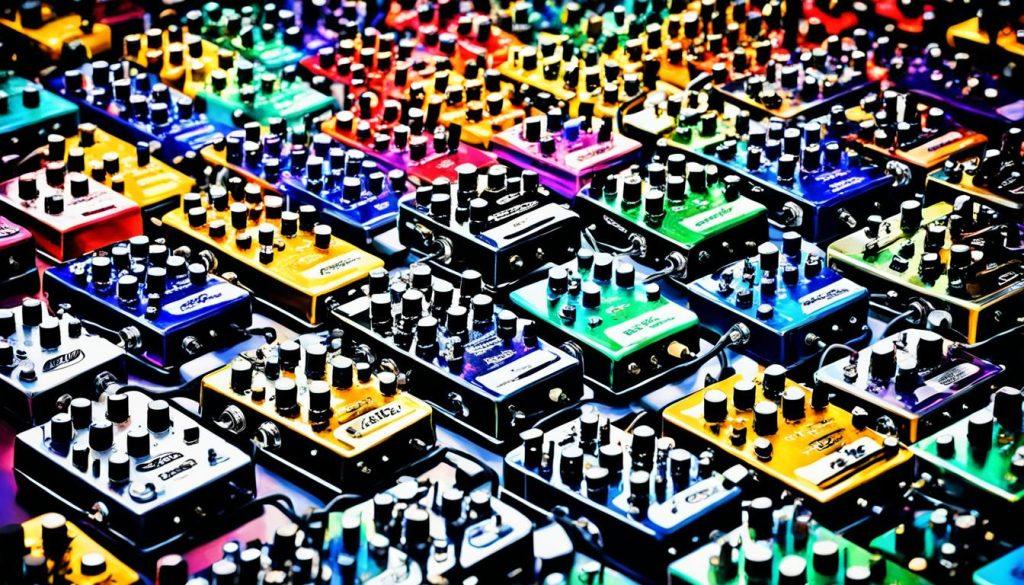
*Disclaimer: The image above is for illustrative purposes only and may not represent the exact models mentioned in this section.*
Understanding Filter Effects
Filter effects are a powerful tool for modifying the frequency range of your sound. They allow you to shape and sculpt your guitar’s tone in unique ways. In this section, we will explore some popular filter effects and their distinctive characteristics.
Wah-Wah Pedals: Create Vocal-Like Expression
One of the most iconic filter effects is the wah-wah pedal. Controlled by foot movement, these pedals allow you to mimic the vocal-like expression of a human voice. By sweeping a resonant peaking filter, you can achieve dynamic and expressive tones. Wah-wah pedals are commonly used in genres like funk, blues, and rock.
Talk Box Effects: Shape Your Sound with a Tube
Talk box effects offer an incredibly unique way to shape your sound. Using a tube that you place into your mouth, you can manipulate the guitar sound by shaping your mouth and vocalizing. This effect is famously used on tracks like Peter Frampton’s “Show Me The Way.” Talk box effects can add a distinctive touch to your playing and are commonly used in rock and funk music.
Auto-Wah: Dynamically Modulate Your Signal
Auto-wah pedals, also known as envelope filters, modulate the signal based on the dynamics of your playing. They automatically adjust the filter response in response to the input signal. This creates a dynamic and responsive sound that can add depth and character to your playing. Auto-wah pedals are popular among funk and jazz guitarists.
EQ Pedals: Precise Frequency Adjustments and Tone Shaping
EQ pedals, or equalizers, allow for precise frequency adjustments and tone shaping. They provide individual control over different frequency bands, allowing you to boost or cut specific frequencies. With an EQ pedal, you can tailor your sound to suit different playing styles or correct any tonal imbalances. EQ pedals are versatile tools that can be used in various genres and musical contexts.
Now that you understand the basics of filter effects, you can experiment with these pedals to add unique textures and flavors to your guitar playing. Whether you want to create expressive wah sounds, shape your sound with a talk box, add dynamic modulation with auto-wah, or precisely adjust your tone with an EQ pedal, filter effects offer endless possibilities for sonic exploration.
Exploring Dynamics Effects
Dynamics effects play a crucial role in shaping the volume and dynamics of your guitar sound. By utilizing these effects, you can achieve the desired level of sustain, control, and impact in your playing. One of the key dynamics effects that every guitarist should be familiar with is the compressor pedal.
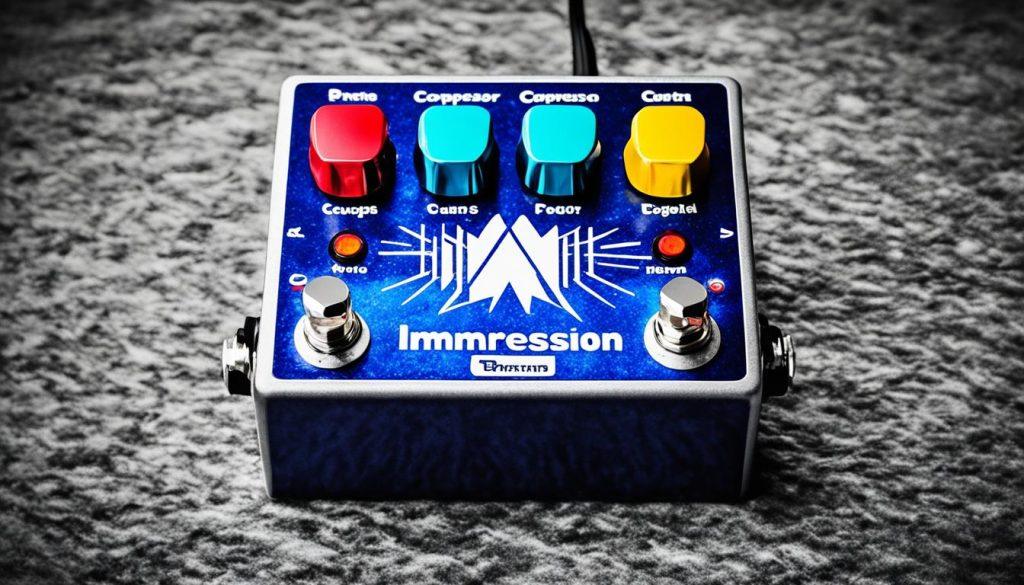
The compressor pedal is a powerful tool that helps even out the volume of your guitar signal by reducing the dynamic range. It acts as a “tone squasher,” leveling out the peaks and boosting the quieter parts of your playing. This effect can enhance the sustain of your solos, ensuring that every note rings out with clarity and intensity.
Not only does the compressor pedal provide a balanced volume, but it also adds a punchy quality to your playing. It can accentuate the attack of each note, resulting in a more articulated and expressive sound. This makes it a favorite among country, funk, and jazz guitarists, where precision and clarity are essential.
“The compressor pedal is like your secret weapon for adding sparkle and control to your guitar sound. Once you start using it, you’ll wonder how you ever played without it!” – Joe Satriani
When using a compressor pedal, it’s important to find the right settings that suit your playing style. The threshold, ratio, attack, and release controls allow you to fine-tune the compression effect to achieve your desired sound. Experimentation is key, as different guitar pickups and playing techniques may require adjustments to get the most out of your compressor.
Benefits of Using a Compressor Pedal:
- Level out volume inconsistencies
- Enhance sustain and note clarity
- Add punch and articulation to your playing
- Bring out the nuances of your guitar tone
- Improve the balance between chords and single notes
By incorporating a compressor pedal into your pedalboard setup, you can take full control of your guitar’s dynamics and achieve a more polished and professional sound.
Other Miscellaneous Effects
Aside from the common types of guitar effects pedals, there are other miscellaneous effects that can enhance your playing experience. These include loopers, multi-effects pedals, and tuners. Let’s take a closer look at each of these:
Loopers
Loopers are a fantastic tool for guitarists who love to experiment and create layered music. With a looper pedal, you can record a musical phrase or chord progression and then have it play back in a loop. This allows you to add additional layers on top, creating complex and captivating soundscapes. Loopers are commonly used by solo performers who want to build up a full arrangement using just their guitar and a loop pedal.
Multi-Effects Pedals
Multi-effects pedals are a convenient all-in-one solution for guitarists who want to experiment with various effects without the need for multiple individual pedals. These versatile pedals offer a wide range of effects, including distortions, delays, reverbs, modulations, and more. They allow you to access a variety of sounds with just a single pedal, making them ideal for gigging musicians or players who want a compact and portable setup.
Tuners
Tuners are an essential tool for every guitarist. Keeping your guitar in tune is crucial for achieving accurate and pleasing sounds. Tuner pedals provide a quick and convenient way to tune your instrument. Modern tuner pedals often feature advanced functionality such as silent tuning, chromatic tuning, and built-in displays to ensure precise tuning accuracy.
By incorporating loopers, multi-effects pedals, and tuners into your collection, you can add versatility, creativity, and precision to your playing.
Now that we’ve covered the various types of guitar effects pedals, let’s proceed to the final section where we offer recommendations for beginners as they embark on their journey to find the perfect pedal.
| Effect | Description |
|---|---|
| Loopers | A pedal that allows you to record and layer loops, creating complex soundscapes. |
| Multi-Effects Pedals | Pedals that combine multiple effects into a single unit, offering versatility and convenience. |
| Tuners | Essential tools for keeping your guitar in tune, ensuring accurate and pleasing sounds. |
Recommendation for Beginners
If you’re a beginner guitarist looking to step into the world of guitar pedals, it’s important to start with a versatile pedal that can cover a range of effects. This will allow you to explore different sounds and experiment with your playing style. Here are some popular options:
| Pedal | Type | Effect |
|---|---|---|
| Donner Stylish Fuzz | Fuzz | Crunchy, saturated tone with harmonic overtones |
| Donner Morpher Overdrive | Overdrive | Smooth, responsive distortion for a classic rock sound |
| Donner Yellow Fall Delay | Delay | Lush, atmospheric repeats that add depth to your sound |
Remember, as a beginner, it’s important to experiment and find the sound that suits your playing style and preferences. These pedals offer a great starting point, but feel free to explore other options as well. The key is to have fun and discover your unique tone.
Tips for Using Guitar Pedals
When it comes to using guitar pedals, there are a few key considerations to keep in mind. From pedal setup to signal chain, these tips will help you get the most out of your effects and achieve your desired sound.
Start with One Pedal and Experiment
When first exploring the world of guitar pedals, it’s best to start with just one pedal. This allows you to focus on understanding how it affects your sound and allows you to experiment with different settings. Whether it’s a distortion pedal, a delay pedal, or a wah-wah pedal, spend some time getting to know its unique characteristics and how it enhances your playing.
Gradually Add More Pedals
Once you feel comfortable with one pedal, you can gradually expand your setup. Adding more pedals to your signal chain can provide a wider range of effects and sonic possibilities. However, it’s important to introduce new pedals one at a time to ensure that each addition complements the existing ones and doesn’t overpower your sound.
Consider the Order of Effects
The order in which you arrange your pedals in the signal chain can significantly impact the overall sound. The general rule of thumb is to place gain-staging effects, such as overdrive and distortion, at the beginning of the chain to shape your tone. Next, you can add frequency effects like equalizers and wah-wah pedals. Modulation effects, such as chorus and flanger, can follow, followed by time-based effects like delay and reverb. Experiment with different combinations to find the perfect order for your pedalboard.
Prioritize Cable Management
As you add more pedals to your setup, cable management becomes crucial for avoiding a tangled mess. Use high-quality cables to ensure a clean and reliable signal flow. Consider using cable ties or pedalboard tape to keep your cables organized and prevent any interference or signal loss.
Signal Chain Order
| Effect Type | Recommended Order |
|---|---|
| Gain-Staging Effects | Overdrive, Distortion, Compression |
| Frequency Effects | Equalizer, Wah-Wah |
| Modulation Effects | Chorus, Flanger, Phaser |
| Time-Based Effects | Delay, Reverb |
| Dynamics Effects | Compressor |
By following these tips for using guitar pedals, you’ll be able to unlock a world of creative possibilities and enhance your overall playing experience. Remember, it’s all about experimenting and finding the combination that resonates with your unique musical style.
Conclusion
Choosing your first guitar effects pedal can be a daunting task, but with the right knowledge, you can make an informed decision. Understanding the different types of pedals and their effects is crucial in finding the perfect fit for your unique sound. From fuzz to overdrive to distortion and more, there are endless possibilities to explore.
Remember, the key to finding your ideal pedal is experimentation. Don’t be afraid to try out different pedals and see how they enhance your playing style. Trust your ears and follow your intuition.
Ultimately, the most important thing is to have fun throughout the process. Enjoy discovering new sounds, creating exciting tones, and unlocking your creative potential. Whether you’re a beginner or an experienced guitarist, the world of guitar effects pedals is an endless playground. Embrace the journey and let your sound soar.
Get your hands on a huge range of downloadable and print resources for guitar players of all interests and ability levels from beginner to advanced at gmiguitarshop.
FAQ
What is a guitar effects pedal?
A guitar effects pedal is a stomp box or footpedal that guitarists use to alter their guitar’s sound. It can be used to add distortion, modulation, delay, filtering, and other effects to the guitar’s signal.
How do I choose the right guitar effects pedal?
Choosing the right guitar effects pedal is subjective, but it’s important to have a solid understanding of the basics. Consider the signal flow, the order of effects on your pedalboard, and the specific effects you want to achieve.
What are gain-staging effects?
Gain-staging effects shape the foundation of your tone. They include gain boost pedals, overdrive, distortion, compression, and volume control pedals.
What are frequency effects?
Frequency effects, also known as filtering effects, include equalizers, wah-wah pedals, and pitch shifters. They allow you to make precise frequency adjustments and add unique sounds to your playing.
What are modulation effects?
Modulation effects add movement and depth to your sound. They include chorus pedals, tremolo pedals, flanger pedals, and phase pedals.
What are filter effects?
Filter effects modify the frequency range of your sound. They include wah-wah pedals, talk box effects, auto-wah, and EQ pedals.
What are dynamics effects?
Dynamics effects control the volume and dynamics of your sound. Compressor pedals are a common dynamics effect that reduce the dynamic range and provide sustain.
What other miscellaneous effects are there?
Other miscellaneous effects include loopers, multi-effects pedals, and tuners. Loopers allow you to record and layer loops, multi-effects pedals combine multiple effects into one unit, and tuners are essential for keeping your guitar in tune.
Which guitar pedals are recommended for beginners?
For beginners, it’s recommended to start with a versatile pedal. Some popular options include fuzz pedals, overdrive pedals, and delay pedals.
What tips do you have for using guitar pedals?
When using guitar pedals, start with one pedal and experiment with how it affects your sound. Gradually add more pedals and consider the order of effects for optimal results. Pay attention to cables used and practice good cable management.
Source Links
- https://www.fender.com/articles/parts-and-accessories/beginner-guitar-pedals
- https://www.donnerdeal.com/blogs/buying-guides/the-ultimate-guitar-pedals-buying-guide-for-beginners
- https://www.sweetwater.com/insync/guitar-pedal-buying-guide/
This post may contain affiliate links. As an Amazon associate, Google associate as well as associate for other programs, Guitar & Music Institute may earn commissions from qualifying purchases.
